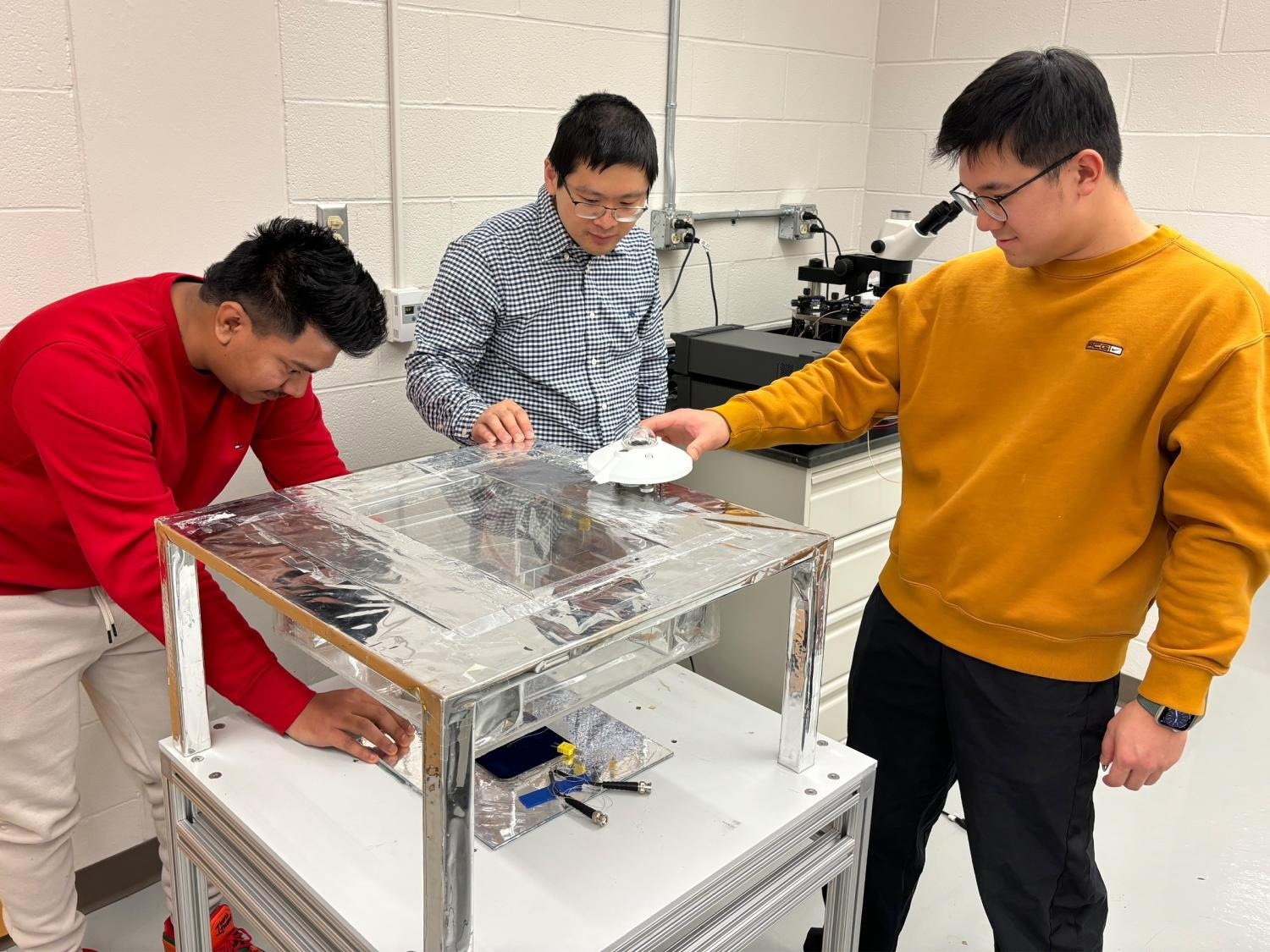Researchers at Penn State are looking to the sun and space, two untapped renewable resources, for solutions to generate power and passively cool buildings as existing energy techniques become increasingly expensive and risky to environmental health.
 From left: Pramit Ghosh, doctoral student in mechanical engineering, Linxiao Zhu, assistant professor of mechanical engineering, and Zhenong Zhang, doctoral student in mechanical engineering, adjust their dual radiative cooler and solar cell harvester. They found the dual harvesting system surpassed the electricity saving of a bare solar cell by as much as 30%. Image Credit: Mariah R. Lucas/Penn State
From left: Pramit Ghosh, doctoral student in mechanical engineering, Linxiao Zhu, assistant professor of mechanical engineering, and Zhenong Zhang, doctoral student in mechanical engineering, adjust their dual radiative cooler and solar cell harvester. They found the dual harvesting system surpassed the electricity saving of a bare solar cell by as much as 30%. Image Credit: Mariah R. Lucas/Penn State
The team, led by Linxiao Zhu, an assistant professor of mechanical engineering, designed and tested a dual cooling and power technique that captures solar energy in a solar cell while directing heat away from Earth via radiative cooling. They presented their energy solution, which is more efficient than either component alone, on March 13th, 2024, in Cell Reports Physical Science.
Radiative cooling works by directing infrared light into outer space without warming the surrounding air.
Zhu demonstrated the idea with the use of a thermal camera. Only a thermal camera, which employs color to indicate temperature, can observe invisible, heat-bearing infrared light.
A human body glows orange or red, suggesting an elevated temperature, whereas a window on a cold day shines blue, indicating a lower temperature. Thermal infrared radiation, also known as blackbody radiation, is the energy that people and objects emit when they cool down.
In radiative cooling, the infrared light radiates from a piece of transparent, low-iron glass. The light bounces off the glass, passes through the atmosphere without warming the surrounding air, and lands in outer space, which we call the cold universe.
Linxiao Zhu, Assistant Professor, Pennsylvania State University
This mechanism cools the surface of the radiative cooler. That cooling capability can then be directed at an object, such as within a building or refrigerator.
Daytime radiative cooling was conceived a decade ago and is currently being researched as a new zero-carbon cooling solution. In 2014, Zhu was a PhD student at Stanford University and was part of the research team that first developed daytime radiative cooling.
At night and during the day, the radiative cooler works as a 24/7 natural air conditioner. Even on a hot day, the radiative cooler is cold to the touch.
Pramit Ghosh, Study First Author and Doctoral Student, Pennylvania State University
The researchers installed a solar panel beneath the radiative cooler so that during daylight hours, sunlight flows through the transparent radiative cooler and is absorbed by the solar cell, generating power.
Last summer, the researchers tested their technology at the Penn State Sustainability Institute's Sustainability Experience Center. They discovered that the combined advantage of energy generation and cooling from the dual harvesting system might outperform the electricity savings of a single solar cell by up to 30%. In other words, harvesting the resources as a pair outperforms using each resource alone.
Zhu added, “Based on these experimental results, using the two harvesters together has the potential to significantly outperform a bare solar cell, which is a key renewable energy technology.”
Another advantage is the unit’s compact size: because the two harvesters are stacked, they take up little space on a rooftop or the ground.
Ghosh added, “At the same time and in the same place, we can exploit these renewable resources together, 24 hours a day.”
The other coauthors, besides Zhu and Ghosh, are Zhenong Zhang, a doctorate student in mechanical engineering at Penn State, and Xinsheng Wei and Hanze Liu, undergraduate mechanical engineering students.
The study was sponsored by the John J. and Jean M. Brennan Clean Energy Early Career Professorship and the Penn State Institute of Energy and the Environment.
Journal Reference:
Ghosh, P., et. al. (2024) Simultaneous subambient daytime radiative cooling and photovoltaic power generation from the same area. Cell Reports Physical Science. doi:10.1016/j.xcrp.2024.101876